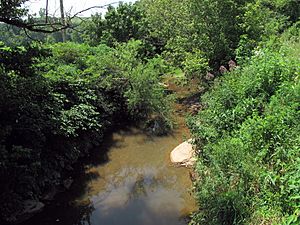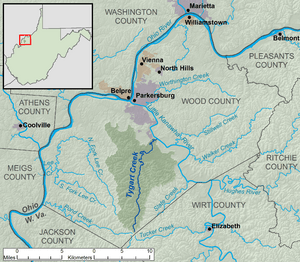Tygart Creek facts for kids
Quick facts for kids Tygart Creek |
|
|---|---|

Tygart Creek near Mineral Wells in 2010
|
|

Tygart Creek and its watershed in Wood County, West Virginia
|
|
| Country | United States |
| State | West Virginia |
| County | Wood |
| Physical characteristics | |
| Main source | south of Rockport 923 ft (281 m) 39°03′13″N 81°33′15″W / 39.0536906°N 81.5542908°W |
| River mouth | Little Kanawha River north of Mineral Wells 587 ft (179 m) 39°12′17″N 81°30′37″W / 39.2047983°N 81.5104003°W |
| Length | 14.5 mi (23.3 km) |
| Basin features | |
| Basin size | 51 sq mi (130 km2) |
Tygart Creek is a small river, or creek, located in the western part of West Virginia in the United States. It's about 14.5 miles (23.3 km) long. This creek is a tributary of the Little Kanawha River, which means it flows into the Little Kanawha River. From there, its water eventually joins the Ohio River and then the mighty Mississippi River, making it part of a very large watershed (an area of land where all the water drains into one main river). Tygart Creek helps drain an area of about 51 square miles (132 km²) of land.
About Tygart Creek
Tygart Creek is an important part of the natural landscape in Wood County, West Virginia. It flows entirely within this county. The creek starts in the southern part of Wood County, near a place called Rockport.
Where Does Tygart Creek Flow?
The creek generally flows north. As it travels, it passes through the towns of Rockport and Mineral Wells. Tygart Creek then flows into the Little Kanawha River from the south. This meeting point is about 2 miles (3.2 km) north of Mineral Wells. It's also about 6.7 miles (10.8 km) upstream from where the Little Kanawha River itself flows into the Ohio River in Parkersburg.
What's Around the Creek?
The land around Tygart Creek is mostly covered by forests. About 71% of the land in the Tygart Creek watershed is forested. Most of these trees are deciduous, meaning they lose their leaves in the fall. The remaining 28% of the land is used for farming, like pastures for animals or growing crops. This information comes from the West Virginia Department of Environmental Protection.

